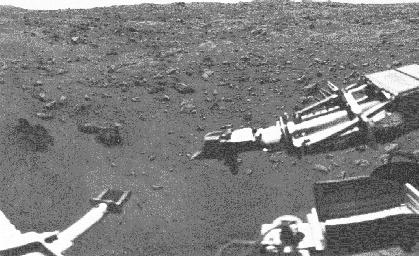

In 1994 scientists at the U of A's Lunar and Planetary Laboratory began to take seriously the possibility that the Face's human resemblance was more than mere coincidence. Robert Storm, a professor at LPL who was involved with the Viking missions, uncovered new photos which clearly showed the Face's remarkable humanoid features. "The data had been hidden by a computer glitch," remarked Strom, "we had to go back to the original magnetic recordings from the spacecraft." The raw data, stored on old 9-track tapes, could not be read by modern equipment. "We put some graduate students to work on it," says Storm, "they were eventually able to restore the old equipment and find the missing pictures."
The Face was originally dismissed by Viking Project scientists at the Jet Propulsion Laboratory as a mere trick of light and shadow. "The new photos suggest that their conclusions may have been a bit premature," says fellow LPL Mars researcher Peter Wesson. Wesson is project leader of Imager for Mars Pathfinder, a stereoscopic camera system that will be sent to Mars later this year.
The conditions on Mars were once right for life to develop. According to Storm, there is abundant evidence that oceans once existed. Aeons ago, with warmer temperatures and liquid water flowing, life may have developed on Mars. Could the Face be an artifact of an ancient Martian civilization? "The possibility has to be taken seriously," says William V. Beantown, a LPL professor who has had his own tangle with the Red Planet. The Beantown team lost a gamma-ray telescope aboard the Mars Observer when the craft mysteriously disappeared just as it entered Martian orbit in August of 1994. "Our final data transmissions were very strange," admits Beantown, "in fact, we detected a massive gamma ray pulse from the northern hemisphere of the planet minutes before the spacecraft vanished." JPL engineers never discovered what happened to Mars Observer in its final seconds.
Mars has come to be known as the Bermuda Triangle of planets. Mars 1, Zond 2, Mars 2, Mars 3, Phobos 1 and Phobos 2 were all lost by the Soviets en route to Mars or shortly after touching down on the surface of Mars. Similarly, the U.S. lost Mariner 3, Mariner 8 and Mars Observer.
Puzzled by these events, the Mars researchers at LPL decided to build their own Mars face. Under the project name "Capricorn Two" they constructed a large simalcrum of the Martian surface, filling it with volcanic soil and rocks exactly like those found on the Martian plains. The area was quickly dubbed "The Mars Garden." Finally, an scale version of the Mars Face was placed in the Garden. "The primary purpose of the Garden was to test instrumentation for the Pathfinder mission, "according to Wesson, "however simulation of the Face quickly became equally important."
"The truth is out there," says Beantown, "it is our duty as scientists to discover it."

 |
 |
 |